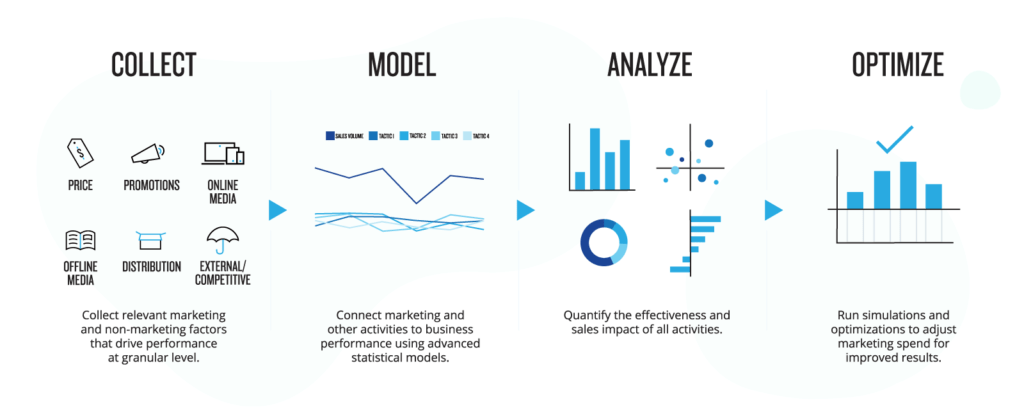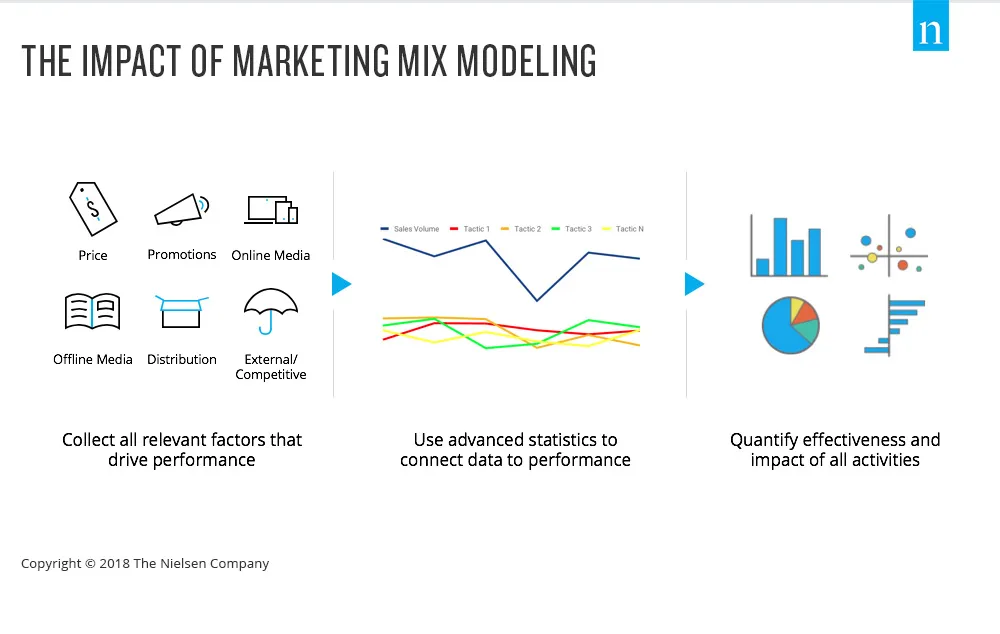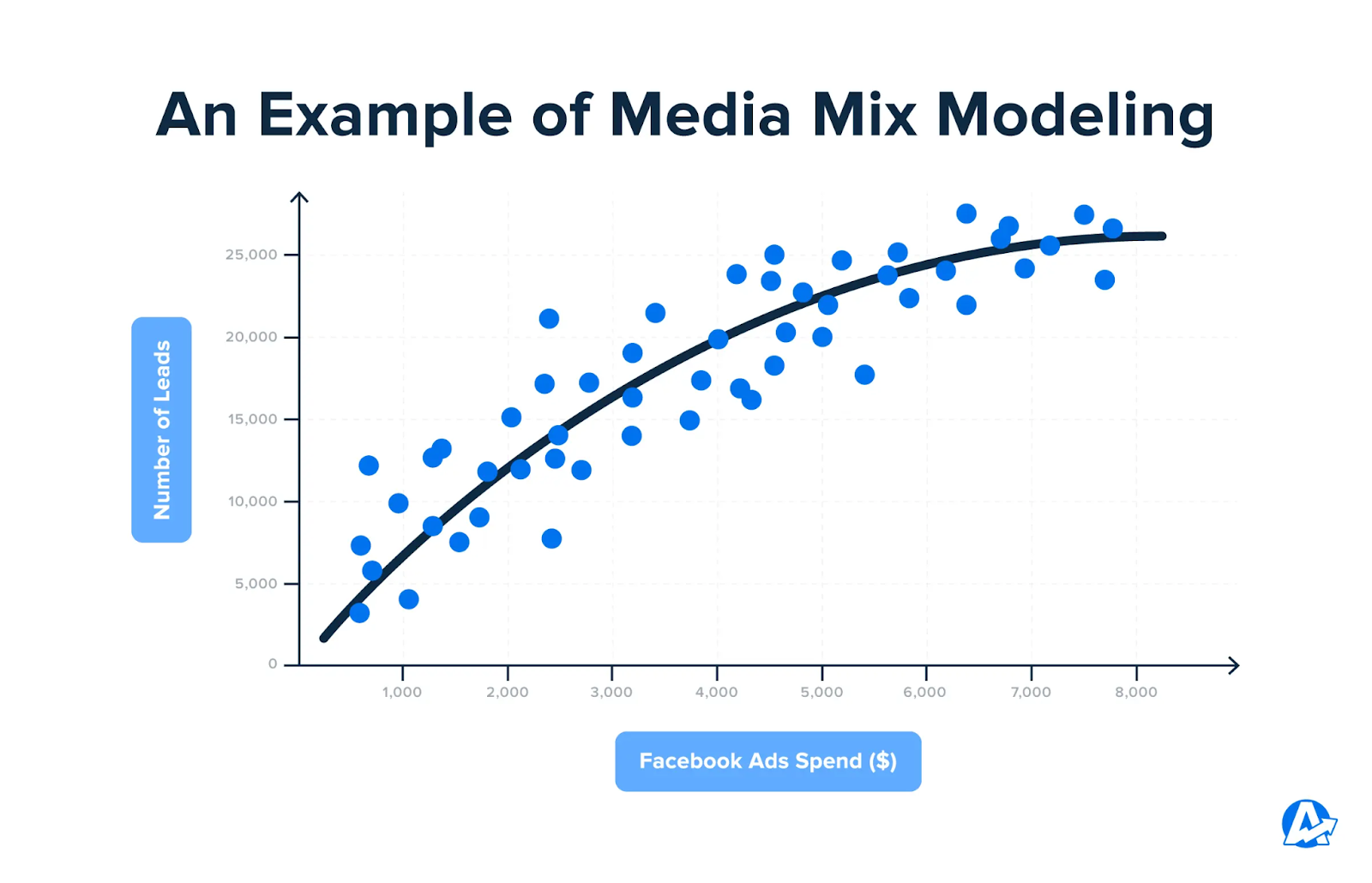In today's marketing world, data is key. With so many marketing channels and challenges, we need a solid method. Marketing mix modeling is that method.
It uses your sales and marketing data to give you a clear picture of your success. This way, you can understand each media channel's impact and make smart changes to your strategy.
This guide will teach you all about marketing mix modeling. You'll learn how it can improve your analytics, boost your ROI, and get better results in 2024. Get ready to make your marketing efforts work their best.
 Source: Fornax
Source: Fornax
Understanding the Basics of Marketing Mix Modeling
Marketing mix modeling (MMM) is a key tool for understanding the impact of marketing efforts. It helps make choices that improve the marketing strategy. It does this by studying data and using statistical analysis. This gives insights into how marketing channels and techniques affect the business.
What is Marketing Mix Modeling?
Marketing mix modeling is a way of scientifically looking at how marketing actions affect important goals. By looking at these factors, marketing mix modeling shows which marketing efforts count the most. This helps make smarter choices about money, improving campaigns, and future plans.
 Source: Bytepawn
Source: Bytepawn
For example, it checks how ads or promotions impact sales or how new customers hear about the brand. It studies different factors like where money goes in marketing, outside events, sales info, and more.
- Marketing spend across various channels (e.g., TV, digital, radio, print)
- Non-marketing factors (e.g., seasonality, economic conditions, competitors' actions)
- Sales and performance data
The Difference Between Media Mix Modeling and Marketing Mix Modeling
There's a slight difference between "media mix modeling" and "marketing mix modeling." The first looks at how different media platforms affect marketing success. In contrast, the latter examines all marketing components, such as your product, its price, where it's sold, and how you promote it.
MMM contrasts with other models, like data-driven attribution, in how detailed it looks at customer journeys. MMM paints a broader picture, focusing on overall marketing success instead.
Even though they look at things differently, media mix and marketing mix models work well together. By using insights from both, businesses can greatly improve marketing spending and outcomes. They help optimize strategies and make every dollar count in a budget.
The Key Components of Marketing Mix Modeling
To use marketing mix modeling (MMM) well, it's vital to know its main parts. These include marketing tactics, sales info, and outside elements. By focusing on these, you can make a strong MMM model that shows your marketing's real impact.
 Source: The Nielsen Company
Source: The Nielsen Company
Marketing Inputs and Variables
Marketing inputs are the parts of your plan looked at in MMM. They might be things like ad spending, pricing, and product launches. These act as the 'drivers' in the model. They help you see what works best in your marketing.
- Advertising spend across various marketing channels
- Promotional activities and discounts
- Pricing strategies
- Product launches and improvements
- Distribution efforts and channel mix
Knowing these factors lets you track and understand your marketing's effect on sales. This insight into what brings in the most sales is very valuable for business.
Sales and Performance Data
Sales info tells you how well your marketing has done. It looks at sales, market share, and other key numbers. These relate to the various marketing strategies.
- Sales volume and revenue
- Market share
- Customer acquisition and retention rates
- Brand awareness and consideration
- Other relevant KPIs
In MMM, this data is the result of all your marketing actions. It helps you see the real sales impact of your strategies. You can tell what part of the sales comes from your marketing directly.
External Factors and Control Variables
MMM also looks at things outside marketing that might affect sales. This helps see the true effect of marketing by removing other influences. It considers things like the time of year or what competitors are doing.
- Seasonality and holidays
- Economic conditions (e.g., unemployment rates, consumer confidence, inflation)
- Weather patterns
- Competitor activities (e.g., promotions, pricing, new product launches)
- Industry trends and market dynamics
By looking at these, your MMM model gets more accurate. This helps you make better choices for your marketing. You can see what really moves sales, despite market changes.
Interpreting Marketing Mix Modeling Results
 Source: AgencyAnalytics
Source: AgencyAnalytics
After setting up your marketing mix model, the key is to read the findings closely. You must look at the stats and get real insight from the numbers.
This model relies on several regression to work, looking at what drives sales. It checks factors like product placement, price, and ads. Then, it shows which area makes the biggest difference in sales.
Checking the model’s validity is critical. You do this through certain tests: Cross-validation lets you see if the model works on new data. You divide the data to teach and test the model.
With out-of-sample testing, you hold back some data. Then, you check how well the model predicts it.
Once you’re sure your model is good, it's time to use the insights. They help in several key ways:
- Refine your ads by knowing which ones work best. Then, you can put more money into the successful areas.
- You can also find the best way to spend your marketing budget. This ensures you get the best return.
- Focusing on what really works means better sales and less money lost.
Grasping your model's results helps you understand the links between marketing and sales. With this knowledge, you can make choices that push your company ahead in a tough market.
Using Marketing Mix Modeling Insights for Strategic Decision-Making
Marketing mix modeling (MMM) shows how different marketing types affect sales. It helps marketers make smart choices and improve their strategies. With MMM, you can use your budget better, find the best channels, and plan for the future.
Optimizing Marketing Budget Allocation
MMM helps you spend your marketing money wisely. It tells you which marketing channel brings in the most sales. This means you can put your budget where it brings the best results.
For instance, MMM might show that ads work better on one platform than another. Knowing this, you can adjust your campaigns to get better results.
Identifying High-Performing Marketing Channels
MMM gives a clear look at how well your marketing works on different channels. It uses data from things like ad campaigns to compare the impact. This helps you spot the best and worst channels.
With this info, you can direct your marketing towards the channels that work best. Keep checking and fine-tuning your mix to meet your goals always.
Scenario Analysis and Forecasting
MMM can also predict what might happen if you change your strategies. With scenario analysis, you get to see the outcomes of different choices ahead of time.
For example, MMM might look at how changing prices affects sales. This helps you set better prices and improve your marketing plan.
It also helps with new product launches. Looking at past data, you can plan future launches for the best impact, reducing any risks.
In the end, marketing mix modeling lets you make better decisions with clear data. It boosts your marketing's impact and leads to better results for your business.
The Benefits of Modern Marketing Mix Modeling
In our world of fast data and change, brands need tools that work quickly. Modern Marketing Mix Modeling (MMM) fits this need perfectly. It helps marketers understand and succeed in today's digital market.
Agility in a Complex Data Environment
Modern MMM is designed to work well with loads of data. It starts with the focus on data itself. This approach helps brands adjust their analytics questions easily. So, in a world with advanced customer platforms and analytics, MMM stands out.
MMM is also good at handling complex marketing. It shows which channels are most effective. With the help of AI and fast computing, any business can use it. This means all sizes of companies can improve their marketing.
Adapting to Changing Market Conditions
MMM is great because it can change as the market does. With a market that's always evolving, it's vital for marketers to stay updated. MMM's dynamic model lets brands tweak their strategies on the go.
As privacy rules get tougher, MMM offers a safe way to check ads. It uses aggregate data and models, protecting user privacy. This way, marketers can still understand how well their ads are doing.
MMM is also quick to give insights. This speed is critical in today's fast market. It lets brands react to changes right away. This helps stay ahead and use marketing money wisely.
Modern Marketing Mix Modeling helps brands be at their best. With its data skills, ability to change with the market, and quick insights, MMM is key. It's a must-have for marketers that want to do well in the digital age.
Marketing Mix Modeling Best Practices
To get the best from your marketing mix modeling, follow some essential steps. Start with cleaning and preparing your data. This is important, as it makes sure your data is ready for modeling.
When you share your results, keep it clear and simple. Use reports and visuals that are easy to grasp. This makes it easier for others to understand and act on your insights.
Remember, marketing mix modeling is not a one-time thing. It should be an always-evolving process. Keep an eye on your models, updating and refining them as needed. This helps you adjust to the changing market quickly.
- Seasonal factors
- Weather conditions
- Economic data
- Competitor data
- Customer insights from conversational analytics
Adding more data points to your model can help a lot. Things like seasonality, weather, and what your competitors are doing. This gives you a better picture of what's driving your marketing. And with this broader view, you can make smarter decisions for your business.
Use Woopra Analytics to Track Your Marketing
To track all your marketing channels well, you need strong analytics. Woopra's tool is great for this. It gives you a full look at how your marketing works across different places. Thanks to Woopra, you can pull info from many spots to get a clearer view.
Woopra helps you keep up with changes in data rules and privacy. It lets you measure your marketing well through things like Marketing Mix Modeling. You'll see the whole journey each customer takes, from when they first notice you to when they buy. This helps make choices based on facts.
With Woopra, you simplify measuring your marketing's impact. You get real advice to help you stand out. By using Woopra, you make your marketing plan stronger, meeting your goals in the years ahead.


